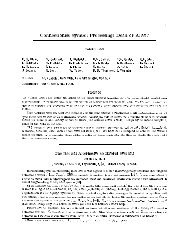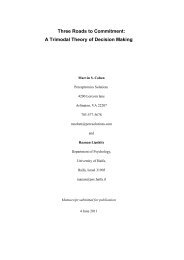Three Roads to Commitment: A Trimodal Theory of Decision Making
Three Roads to Commitment: A Trimodal Theory of Decision Making
Three Roads to Commitment: A Trimodal Theory of Decision Making
You also want an ePaper? Increase the reach of your titles
YUMPU automatically turns print PDFs into web optimized ePapers that Google loves.
<strong>Three</strong> <strong>Roads</strong> <strong>to</strong> <strong>Commitment</strong>: A <strong>Trimodal</strong> <strong>Theory</strong> <strong>of</strong> <strong>Decision</strong> <strong>Making</strong> 60<br />
<strong>of</strong> the Human Fac<strong>to</strong>rs and Ergonomics Society 38th Annual Meeting, Santa Monica, CA.<br />
Orasanu, J., & Fischer, U. (1997). Finding decisions in natural environments: The view from the cockpit. In C.<br />
Zsambok & G. Klein (Eds.).Naturalistic <strong>Decision</strong> <strong>Making</strong> (pp. 343-357). Hillsdale, NJ: Erlbaum.<br />
Payne, J., Bettman, J.R., & Johnson, E.J. (1993). The adaptive decision maker. New York: Cambridge University<br />
Press.<br />
Pearl, J. (2000). Causality: models, reasoning, and inference. Cambridge UK: Cambridge University Press.<br />
Pearl, J. (1989). Probabilistic reasoning in intelligent systems: Networks <strong>of</strong> plausible inference. San Mateo CA:<br />
Morgan Kaufmann Publishers.<br />
Penning<strong>to</strong>n, N., & Hastie, R. (1992). Explaining the evidence: Tests <strong>of</strong> the s<strong>to</strong>ry model for juror decision making.<br />
Journal <strong>of</strong> Personality and Social Psychology, 62(2), 189-206.<br />
Pirolli, P. (2007). Information Foraging <strong>Theory</strong>: Adaptive Interaction with Information. Oxford: Oxford University.<br />
Poletiek, F. (2001). Hypothesis-testing behavior. Philadelphia: Psychology Press.<br />
Popper, K. R. (1994). The Myth <strong>of</strong> the Framework. New York: Routledge.<br />
Popper, K. (1995). Conjectures and refutations. New York: HarperCollins.<br />
Prelec, D., & Bodner, R. (2003). Self-signaling and self-control. In G. Loewenstein, D. Read & R. Baumeister<br />
(Eds.), Time and <strong>Decision</strong>: Economic and Psychological Perspectives on Intertemporal Choice (pp. 277-<br />
98). New York: Russell Sage Foundation.<br />
Quine, W. V. O., & Ullian, J. S. (1970). The web <strong>of</strong> belief. New York: Random House.<br />
Raiffa, H. (1968). <strong>Decision</strong> analysis: Introduc<strong>to</strong>ry lectures on choices under uncertainty. Reading, MA: Addison-<br />
Wesley Publishing.<br />
Rasmussen, J., Pejtersen, A. M., & Goodstein, L. P. (1994). Cognitive systems engineering. New York: Wiley.<br />
Raz, J. (1990). Practical Reason and Norms. Prince<strong>to</strong>n NJ: Prince<strong>to</strong>n University Press.<br />
Rescorla, R. A., and Wagner, A. R. (1972). <strong>Theory</strong> <strong>of</strong> Pavlovian conditioning: Variations in the effectiveness <strong>of</strong><br />
reinforcement and nonreinforcement. In J. B. Black & .. F. Prokasy (Eds.), Classical Conditioning II (pp.<br />
64-99). New York: Apple<strong>to</strong>n-Century-Cr<strong>of</strong>ts.<br />
Rudolph, J. W. (2003). In<strong>to</strong> the Big Muddy and Out Again: Error Persistence and Crisis Management in the<br />
Operating Room: Bos<strong>to</strong>n College The Carroll Graduate School <strong>of</strong> Management Department <strong>of</strong><br />
Organization Studies.<br />
Sacks, H. (1995). Lectures on conversation. Malden, MA: Blackwell.




